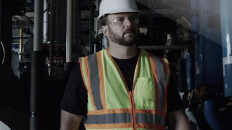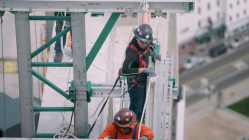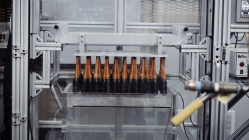Safety Tips – Brought to you by Westex
Electrical Safety Tips
As an electrical worker, the manner in which you choose to work and the work practices that you follow affect your life and the lives of your Brothers and Sisters every day. Over the years you have been trained and developed skills that help keep you safe on and off of the job. This web page is intended to help share some of those safe work skills with other IBEW electricians. We have all grown beyond the negitive image that safety is a top down mandate to something that we can all embrace. Please take a momement and review some of these tips and if you have a tip you want to share please tell us about it.
Arc Flash
An arc flash can change your life in less than a second. An arc flash event can release molten debris, extremely high radiant heat, acoustical energy , a pressure wave, and blow a hole in your pliers. NFPA 70E, “Standards for Electrical Safety in the Workplace”, addresses electrical safety requirements for an employee in the workplace during installation, operation, and maintenance activities. However, as an electrical worker, it is always a good idea to wear, arc rated clothing at work every day because arc flashes are not always predictable. An adequate level of arc –rated clothing and other PPE must be determined from a hazard assessment for the task to be performed.
Silica
Crystalline silica is found in concrete, mortar, bricks, cement, plaster, tile, and stone. The installation, cutting, drilling and sawing of these materials cause the silica dust to be suspended in the air and then inhaled into a workers lungs. Overexposure to silica may result in a worker contracting silicosis, a severe lung disease. Here are a few tips to help protect you from exposure to silica:
1. Replace crystalline silica materials with a safer substitute, whenever possible.
2. Use all available work practices to control dust exposure, such as water sprays.
3. Wear a respirator that offers a good seal between the respirator and the face.
4. Care should be taken to remove any accumulated dust from clothing before leaving the work site.
5. Remember: If it is silica, it is not just dust.
Noise Protection
Employers are required to supply hearing protection when sound levels exceed permissible levels. Typically these areas are where noise level are sustained for long durations. As an employee you should always consider the use of hearing protection when sound levels can reach high decibel levels for short periods of time as when working with power tools or near heavy equipment.
Falling Debris
When debris and trash is dropped to lower level waste bins and containers there are certain rules and tips you should follow.
1. When debris is dropped through holes in the floor without the use of shuts, the area onto which the material is dropped should be protected with barricades.
2. Signs warning of the hazard of falling material should be posted at every level.
3. When materials are dropped more than 20 feet to any point lying outside of the exterior walls of the building, an enclosed chute constructed of wood or equivalent shall be used.
Rigging Equipment
Most of us do not use rigging equipment every day but when you do find yourself rigging for material handling here are a few tips you should know.
1. All equipment should be inspected prior to use and ensure that it is safe.
2. Defective equipment should be removed from service immediately.
3. All rigging equipment must have a permanently affixed and legible identification marking that recommends its safe working load.
Tools
Despite the fact that tools are an integral part of their work, workers often take for granted the hazards associated with their use. Often these hazards arise from using the wring tool for the job or failing to take proper safety precautions before using the tool. Here are a few tips to consider before using any tool.
1. Inspect all tool prior to use for wear or damage. If the tool is damaged, do not use it.
2. When power tools are designed to accommodate guards, they should be equipped with such guards when in use.
3. Hand held power tools, such as circular saws and chain saws without a positive accessory holding means, should be equipped with a constant pressure switch that will shut off the power when the pressure is released.
4. Power tools should be double-insulated or grounded.
5. Never use the electric cord of a power tool for hoisting or lowering of the tool.
Fall Protection
Falls are the leading cause of worker fatalities in the construction industry. Electrical workers face fall hazards everyday on just about every type of job. To help try and prevent injury from falls here are a few tips to keep in mind.
1. Try to engineer out the hazard and perform as much work as possible on the ground.
2. Completely inspect all personal fall arrest systems prior to use for wear, damage and other deterioration.
3. When inspecting your work area, make sure that all holes are covered and marked and that guardrail systems are properly installed.
4. Never use the top two steps of a ladder.
First Aid
By definition First Aid is the provision of emergency care for an illness or injury until actual medical treatment can be accessed if needed. Minor cuts and scrapes are common place on any job site or office and according to OSHA; employers shall provide first aid kits on the jobsite. To help prevent infection and to expedite treatment it is a good idea to keep a small first aid kit near your person at all times while at work. It is a good idea to include the following in your personal kit.
1. Antiseptic wash
2. Gauze squares
3. Neosporin or other triple antibiotic ointment or cream
4. Medical tape (plastic or paper)
5. Alcohol wipes
6. Aspirin
7. Bee sting kit
8. Sunburn treatment (aloe product)
9. Benadryl
10. Eye wash
It is also a good idea to keep a small first aid kit in your car, boat, home or camper.
Dehydration
Dehydration is a condition that occurs when the loss of body fluids, mostly water, exceeds the amount that is taken in. With dehydration, more water is moving out of our cells and then out of our bodies than the amount of water we take in through drinking.
We lose water every day in the form of water vapor in the breath we exhale and as water in our sweat, urine, and stool. Along with the water, small amounts of salts are also lost.
When we lose too much water, our bodies may become out of balance or dehydrated. Severe dehydration can lead to death.
An adequate supply of potable water should be available in all places of employment. Portable containers used to dispense drinking water capped tightly, equipped with a tap and clearly marked as drinking water. As a worker you should take advantage of this water supply and keep your body hydrated. When possible keep a container of water close to you when working for quick hydration.





















